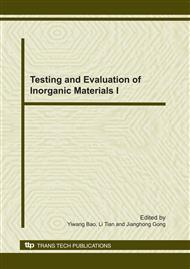p.349
p.352
p.357
p.361
p.364
p.369
p.373
p.378
p.382
Microstructure and Properties of Al2O3-ZrO2(n) Composite Ceramics Prepared by Microwave Sintering
Abstract:
Al2O3-ZrO2(n) composite ceramics were prepared by microwave sintering. The properties and microstructure were investigated, including vickers hardness, fracture toughness, bending strength, wear resistance and heat-shocking resistance. The results show that the properties and microstructure of alumina matrix ceramics are affected by the addition of nano-ZrO2 particles. When the content of ZrO2 is 15vol%, the hardness, fracture toughness and bending strength of the Al2O3-ZrO2 composites reach maximum values 13350MPa, 6.41MPa•m1/2 and 502MPa, respectively. The wear resistance of alumina matrix ceramics are improved only on the condition of adding an appropriate amount of nano-ZrO2. The wear mechanism of the composites are abrasive particle wear and adhesion wear co-existing. The crack propagation rate of Al2O3 matrix ceramics decreases remarkably with the addition of nano-ZrO2 particles. The mechanisms of ZrO2 improving the heat-shocking resistance of alumina matrix ceramics are mainly phase transfer toughening. Nano-ZrO2 particles exist in the intragranular and grain boundary of alumina matrix ceramics, and exist intragranular structures.
Info:
Periodical:
Pages:
364-368
Citation:
Online since:
December 2010
Authors:
Price:
Сopyright:
© 2011 Trans Tech Publications Ltd. All Rights Reserved
Share:
Citation:


